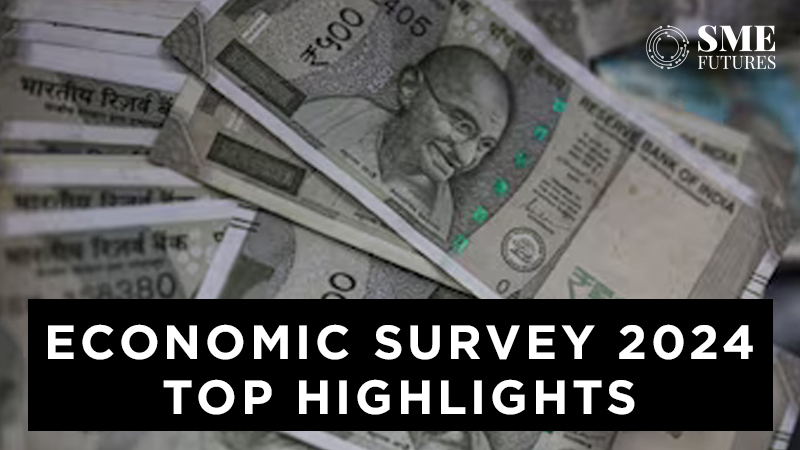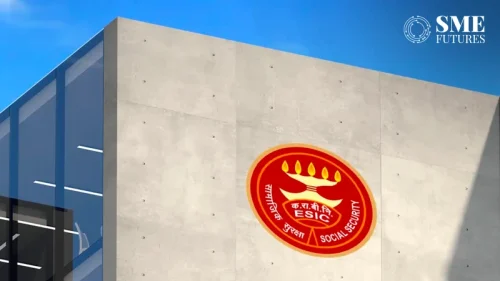Ahead of union budget 2024, Finance Minister Nirmala Sitharaman has tabled the Economic Survey 2023-24 in Parliament today. The survey outlines the Indian economy’s performance and prospects, presenting a comprehensive analysis across various sectors. Here are the top highlights of the Economic Survey:
State of the Economy
- GDP Growth: The survey projects a real GDP growth of 6.5-7% for FY24. India’s real GDP grew by 8.2% in FY24, maintaining robust growth despite external challenges.
- Inflation and CAD: Retail inflation decreased from 6.7% in FY23 to 5.4% in FY24. The Current Account Deficit (CAD) improved to 0.7% of GDP, down from 2.0% in FY23.
- Tax Collection and Expenditure: 55% of tax revenue came from direct taxes, while 45% was from indirect taxes. The government has also ensured free food grains to 81.4 crore people and progressively increased capital spending.
Monetary Management and Financial Intermediation
- Banking Sector Performance: India’s banking and financial sectors performed excellently, with credit disbursal by Scheduled Commercial Banks (SCBs) reaching ₹164.3 lakh crore, a 20.2% increase by March 2024.
- Credit Growth: Double-digit growth in bank credit was driven by lending to services and personal loans. Industrial credit grew by 8.5%, and agriculture and allied activities witnessed double-digit credit growth.
- Financial Inclusion: The survey emphasises the importance of Digital Financial Inclusion (DFI) for sustainable economic growth and highlights the Indian microfinance sector as the second-largest globally.
Prices and Inflation
- Policy Interventions: Government and RBI measures helped maintain retail inflation at 5.4%, the lowest since the pandemic. Significant price cuts for LPG, petrol, and diesel contributed to low retail fuel inflation.
- Core Inflation: Core services and goods inflation reached multi-year lows. Food inflation rose to 7.5% in FY24 due to extreme weather and crop damage, but government actions mitigated the impact.
External Sector
- Trade Performance: India’s services exports grew by 4.9% to USD 341.1 billion, with IT/software services leading. India remains the top global remittance recipient, with USD 120 billion in 2023.
- External Debt: The external debt to GDP ratio stood at 18.7% at the end of March 2024, indicating sustainable levels.
Medium-Term Outlook
- Growth Strategy: The focus areas include job creation, agriculture potential, MSME bottlenecks, green transition, and financial market deepening. The survey stresses the need for a tripartite compact between the Union Government, State Governments, and the private sector for 7% plus growth.
Climate Change and Energy Transition
- Climate Action: India is the only G20 nation aligned with a 2-degree centigrade warming target. The share of non-fossil sources in electricity generation capacity reached 45.4% by May 2024.
- Renewable Energy: India’s efforts in renewable energy and clean fuels are increasing, with significant cost savings and emissions reductions.
Social Sector
- Welfare Programmes: Digitalization has amplified the impact of welfare spending. The Ayushman Bharat scheme generated over 34.7 crore cards, covering 7.37 crore hospital admissions.
- Education and Healthcare: The ‘Poshan Bhi Padhai Bhi’ program aims to develop the world’s largest universal preschool network, and the Vidyanjali initiative enhanced educational experiences for over 1.44 crore students.
Employment and Skill Development
- Labour Market: The unemployment rate declined to 3.2% in 2022-23. The female labour force participation rate has been rising, and the EPFO membership grew by 8.4% CAGR between FY15 and FY24.
- Gig Economy: The gig workforce is expected to expand to 2.35 crore by 2029-30, with significant job creation required to meet the rising workforce demand.
Agriculture and Food Management
- Agricultural Growth: The sector registered an average annual growth rate of 4.18%. Credit disbursed to agriculture amounted to ₹22.84 lakh crore by January 2024, supporting farm incomes and productivity.
Industry
- Industrial Growth: Economic growth in FY24 was supported by a 9.5% industrial growth rate. PLI schemes attracted over ₹1.28 lakh crore of investment, leading to substantial production, sales, and employment generation.
Services
- Sector Performance: The services sector contributed to 55% of GVA, with exports of computer and business services leading. The aviation sector and real estate markets saw significant growth.
Infrastructure
- Public Investment: Public sector investment played a key role in funding large-scale infrastructure projects. NH construction and railway capital expenditure saw substantial increases, enhancing transportation infrastructure.
Climate Change and India’s Perspective
- Global Strategies: The survey critiques global climate strategies and emphasises India’s ethos of harmony with nature. The ‘Mission LiFE’ promotes mindful consumption to address global climate challenges.
The Economic Survey 2023-24 presents a positive outlook for the Indian economy, highlighting significant achievements and outlining strategic focus areas for sustained growth.
What experts say
Ranen Banerjee , Partner and Leader Economic Advisory, PwC India says the Chief Economic Advisor has sounded a cautious note by projecting a growth rate of 6.5-7.0% for FY25, highlighting the global uncertainties and domestic challenges.
“There is a nudge to governments to let go of various regulations, citing the Ishopanishad. There is also a nudge to the private sector to invest in IP, machinery and equipment. Academia has been nudged to provide the necessary skills and knowledge for IP creation. There is an acknowledgement of the challenges faced by our exports, manufacturing and small and medium enterprises. There is also a hint at lowering our emphasis on manufacturing and adopting the agricultural sector too as a generator of jobs, which comes from a statement that our choices cannot be binary. We now await the Union Budget to see how these headwinds highlighted in the Economic Survey are countered by the fiscal outlays and policies,” he said.
Nilaya Varma, Co-Founder and CEO at Primus Partners comments that Economic Survey highlights a significant issue: the lack of timely and detailed job creation data, which hampers accurate job market analysis.
“Despite this, job growth in trade and services underscores the need for a sustainable employment market and a shift from agriculture to manufacturing. The survey also emphasises the critical role of Production-Linked Incentive (PLI) schemes and the manufacturing sector in driving growth,” he said.
Moreover, the survey stresses the importance of AI and technology in the job cycle, calling for a partnership between the government, private sector, and academia. For sustainable progress, this collaboration should focus on relevant skills and education, promoting manufacturing that supports thriving SME clusters and embracing sustainable growth.
“This partnership aims to restart the mission to skill and equip Indians to keep up with and get ahead of technological changes. To succeed, the government must empower industry and academic institutions to effectively play their roles in this endeavour,” he added.
Prashant Sharma, President, NAREDCO Maharashtra commend the comprehensive Economic Survey 2024. “The survey highlights significant strides in infrastructure development, which is crucial for sustained economic growth. The focus on enhancing urban infrastructure, particularly in Tier II and Tier III cities, aligns perfectly with the real estate sector’s goals of promoting balanced regional development and addressing urban migration challenges. The survey’s insights on sustainable and green construction practices resonate with our commitment to environmentally responsible development,” he said.
The survey also highlights a pivotal shift in the economic landscape with healthier corporate and bank balance sheets poised to bolster private investment. This positive trajectory is mirrored in the residential real estate market, where we are witnessing a significant uptick in household sector capital formation.
“Moreover, the projected economic growth and improvement in consumer confidence will positively impact the housing market, encouraging more home buyers to invest in real estate. We are optimistic that the policies and initiatives outlined in the Economic Survey will pave the way for a robust and resilient real estate sector, contributing significantly to the nation’s economic prosperity.” he added.











